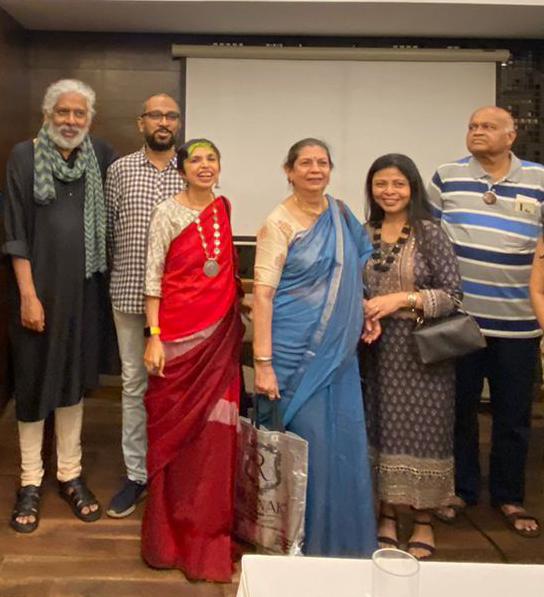Memorial Committee
The Bimal Roy Memorial & Film Society
The Bimal Roy Memorial & Film Society was set up in 1997 to champion the cause of sensitive cinema and keep Bimal Roy’s unique legacy alive. Know more about the history of BRMFS, the activites undertaken by BRMFS and also view press clippings.
Committee
Rinki Roy Bhattacharya
Film Scholar | Writer | Filmmaker
Chairperson: Bimal Roy Memorial Society Est 1997
Suresh Mhatre
Film maker. Produced over 250 adfilms and 3 feature films
Roopa Barua
Writer and documentary filmmaker based out of Mumbai, India
Anando Dutta
Graphic design and Communication Strategist, Educator, School of Design and Innovation (ISDI).
Maithili Rao
Freelance film critic who has written for Indian and foreign publications, and author of ‘Smita Patil : A Brief Incandescence’.
A Message from Chairperson Rinki Roy Bhattacharya
A reminder of how BRMC was born.
In this dazzling business of making movies, there are many who silently create screen magic. Work from behind the scene. Inevitably these artists go unnoticed. Remain unsung, unrecognized.
Amongst them are brilliant artists & technicians .
Our response to the fact these unknown artists deserved to be publicly honoured, set up BIMAL ROY MEMORIAL 23 years back, February 7, 1997. We created SMRITI SANDHYA – an evening of nostalgic music that we love. The first SMRITI SANDHYA was a musical biography of my father. Everyone’s BIMALDA.
It was an evening to remember!
Each SMRITI SANDHYA focused on yesteryear’s composers, and lyricists Sahirsaab, Shailendra who are stars in their own right.
On this musical platform we celebrated hidden talents. For example, we awarded press photographer R.M.Kumtakar. The man who captured stills of movie icons but remained invisible.
I am proud of the gems we rediscovered. We honoured Dilip Gupta who imaged Madhumati
R.D.Mathur – who shot magnificent Mughal- e- Azam,
Sound recordist Robin Chatterjee
Nimmiji along with her writer husband Ali Raza.
Make-up man Pandhari dada who passed away last week.
Lyricist Yogesh who wrote ANAND songs .
And P.K.Nair the creator of the NATIONAL FILM ARCHIVE, to recall a few.
The emerging directors list making socially inspired themes has Ashutosh Gowariker, Vikramaditya Motwane, ,Shoojit Sircar, Neeraj Ghayawan. This year BRMC honoured Amit Sharma . I am happy to find that Amit has adopted the humanist tradition of Bimal Roy, brilliantly with his Badhaai Ho.
The 2020 Jury also selected film-maker Gitanjali Rao for her poetic amination debut Bombay Rose.
My friend Sanjit Narwekar is awarded for his scholarly documentation. . A.K.Bir receives the award for his exquisite camerawork as much for his contribution to position Odiya cinema globally. And for veteran composer, Anandji ji bhai of DON and more than 200 magnificent works, we have the 2020 Lifetime Achievement award.
WE ALL WORSHIP CINEMA.
These 23 years have not been easy. Believing in our work, we survived.
Our most important work, I believe, is to create the booklets…that contain important archival material for film students and museums…
In 1952 My father created the BIMAL ROY PRODUCTIONS. It was his family.
In 1997 We founded the BIMAL ROY MEMORIAL with that same spirit of solidarity We are FAMILY.
I sincerely thank everyone who support us. With your support we will rewrite the history of many forgotten legends of Indian cinema.
Rinki Roy Bhattacharya
Landline : 022-26403041 | Mobile : 91- 9833307359 | Email : roy.rinki@gmail.com
Excerpt of panel discussion at the launch ‘Bimal Roy’ website

The film with an intensely serious theme questioning patriarchy, the class system, exploitation, became a great popular success with winding queues for tickets and people reciting its dialogues.
Sonali also said she wept in the theatre when she saw Roy’s Kabuliwala which had in today’s terms such a strong Muslim character but then it did not focus at all on his religion..
Sanjit Narwekar, senior film critic and author of books on cinema, who presided, felt Bandini was one of Roy’s most complete films. Other participants were Anando Dutta, designer, Ambarish Roy Chaudury, critic and Nandita Puri, journalist. The evening ended on a humorous note with Nandita observing that a Marathi Manoos had survived four Bongs in the panel.
With Udayer Pathe, a new star was born in BIMAL ROY, said his daughter Rinki.
As cinematographer, that star quality was evident after he shot P.C .Barua’s MUKTI. Deservedly, Barua celebrated his handsome young cinematographer, Bimal Roy, by splashing his name on MUKTI’s bill boards along with stars. I doubt very much this incredible phenomenon of mentioning the cinematographer with stars, has been repeated anywhere in the world. But the meteoric journey of director Bimal Roy begins with the 1944 film Udayer Pathe. Indeed that film maker was destined to change the contours of Indian cinema. Early Film acting, if we recall, was theatrical, melodramatic. The shift came after Udayer Pathe. Acting became natural and “wholly suited to cinema” observed Satyajit Ray. Growing up in that charmed era, in the glow of the film’s limelight – I witnessed its sweeping impact on Bengali society. The film ran nonstop for one whole year in Kolkata’s Chitra cinema. Talked about enthusiastically in posh drawing rooms, women wanted to dress and speak like the heroine Binota Ray. Till date New Theatre’s most successful film, it compelled the studio to remake the Hindi version HAMRAHI within two years. HAMRAHI created another historic chapter…given a tumultuous release in all over India as far as Lahore which was in north India. People were in disbelief. Could a film move them so powerfully? And can a film be so closely resemble life? Someone once remarked that if a film moves even two people, it is to be considered extraordinary. To think that this film moved an entire generation of movie goers – and future movie makers – is an incredible phenomenon.
I have met people who watched HAMRAHI 20 times. Met euphoric Bengalis who cannot stop talking about Udayer Pathe. Whose lives were touched by its humanistic ideology. These days we hear endless debates about what constitutes nationalism. Here is a film that has the answer. Nationalistic fervour flowed in every vein of Udayer Pathe .It’s aura spread from door to door in pre Independent India from the film.
Young progressive thinkers, intellectuals, writers , the future Ritwick Kumar Ghataks, Satyajit Rays, Tapan Sinhas, Mrinal Sens, Nabendu Ghoshs were inspired by Udayer Pathe. Many later joined Bimal Roy. Ritwick Ghatak, for example, assisted him in Tathapi made in Kolkata. Wrote the astonishing Madhumati. Tapan Sinha was Roy’s sound recordist and Nabendu Ghosh remained Bimal Roy’s screenplay writer. On the other side, the acclaimed Satyajit Ray aspired to write for Roy. In his remarkable piece My Film Guru ,Nabendu Ghosh recalled seeing lathi charge outside a Rajshahi theatres and wrote :“I saw a serpentine queue for tickets outside a cinema hall. Then I saw booklets of Udayer Pathe hanging like festoon in corner shops! Never did a film create this unbelievable impact , it was something unheard of!! After watching Udayer Pathe, I decided on the spot , if I ever joined films, it will only be to work with this Bimal Roy” In Udayer Pathe the prevalent mood is of political dissent. Conceived in that mood the film confronts the elite class of Westernised Indians, who aped British rulers. Many of us would, I know, identify with the honest journalist who challenges the insensitivity of the rich, and powerful. What never fails to amaze are the many layers of social fabric Udayer Pathe engages with. The film addresses plagiarism, copyright infringement, trial by the media, gender sensitivity, class chasm, workers’ rights, and the naiveté of the ordinary middle class victims of shrewd manipulation by the wealthy. So many relevant issues set against the landscape of the 1943 manmade Bengal famine. The film’s dialogues sound are written with total irreverence .They are witty, cheeky – yet they do not resort to vulgarity. On the contrary, Udayer Pathe is written with an ear for literary finesse. So popular was the entire audio track of the film, that the famous Hindustan Record company released the film’s track 75 rpm records. Radio plays were produced that ran on the radio for days. Records sold like hot cakes. This must be the ONLY film to enjoy that unique privilege. Arguably, Udayer Pathe is Bimal Roy’s most radically political film. He plunges into the subject with supreme confidence. The film, today’s audience discovered with surprise, is incredibly modern. Watching it now, people are forced to recognise its socio economic relevance

Bimal Roy
Bimal Roy Memorial, All Rights Reserved © 2021
Designed & Developed by Trimoorti Creations.

Bimal Roy
All Rights Reserved © 2021
Designed & Developed by Trimoorti Creations.

